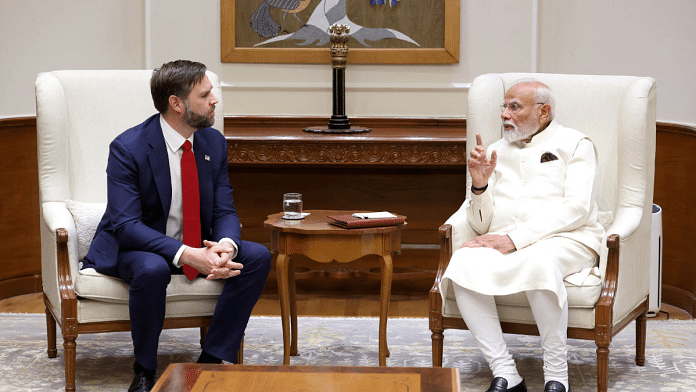Can India replace China?
Vance’s visit, according to some Chinese commentators, is a trigger for a “Made in China versus Made in India” rivalry. But others argue that the competition is premature, citing India’s systemic constraints – underdeveloped infrastructure, slow regulatory processes, and continued reliance on Chinese imports. Even with efforts to shift supply chains, Chinese-made products are expected to remain dominant. To underline the irreplaceability of “Made in China,” one Weibo post shared photos of a dress worn by Usha Vance, JD Vance’s wife, upon her arrival in India, highlighting that even though her outfit was from a London-based brand founded by an Indian designer, it was made in China.
While American companies like Apple are expanding operations in India, Chinese analysts remain skeptical that New Delhi could beat Beijing’s production capabilities. One commentator pointed out that China’s manufacturing advantage lies not just in cost but in systemic efficiency that no other country can replicate. “Apple’s needs can be met within 24 hours [in China], with a supply chain radius of less than 100 kilometres. This speed and scale cannot be matched by India, Vietnam, or even the US,” the commentary noted.
Zhang Wenjie, General Manager of Wenzhou-based Desay Group, argued that ‘Made in China’ remains irreplaceable in global markets. According to him, Indian products suffer from poor quality and a damaged brand image, while Vietnamese goods are 20 per cent more expensive and still inferior. For Zhang, this confirms that China’s manufacturing dominance remains unchallenged.
Also read: ‘Neo-Cold War mentality’, ‘arrogance’—Chinese are fuming over JD Vance’s ‘peasants’ remark
Made in China supremacy
The Chinese internet is flooded with questions like “Can Make in India replace Made in China?” The overwhelming response from commentators is a resounding no. Some posts even claim that India’s manufacturing ambitions are shattered, with Prime Minister Narendra Modi’s “desinicisation” efforts becoming an international laughing stock.
Another Weibo user questioned why, despite a decade of the high-profile “Make in India” push modelled on East Asia’s success story, India has failed to replicate China’s rapid rise. The post argues that while China and the US benefit from accumulated technology and talent, India’s demographic dividend is losing value in an era of automation. It further criticises India’s weak basic education and engineering training, dismissing its demographic advantage as an illusion. “History never rewards latecomers,” it asserts, adding that India’s slow growth story speaks volumes about the deeper differences it has with China – in terms of education, talent development, and industrial systems – which cannot be closed overnight.
A China Central Television (CCTV) reporter emphasised that while population size is crucial for establishing a workforce, quality is paramount. China’s working-age population averages 11 years of education, while new labour force entrants have at least 14 years’ worth. This gives the country a “talent dividend” far surpassing India’s, whose education system struggles to provide a similarly skilled workforce. This has allowed China to maintain its economic momentum and global leadership.
Chinese commentary consistently highlights the feasibility challenges surrounding India’s manufacturing aspirations. The critiques point to persistent issues such as skill shortages, regulatory delays, financial bottlenecks, and continued dependence on imports. One analyst emphasised that India’s manufacturing sector is “congenitally deficient.”
The Chinese perspective also underscores the contrast between New Delhi and Beijing in terms of productivity and infrastructure.
While India boasts a young population, its lack of vocational training and higher labour costs hinder progress. Labour productivity in India is just 22 per cent of China’s, making it less competitive. In the solar and electronics sectors, India remains heavily reliant on Chinese supply chains. Meanwhile, China’s deeply integrated, self-sufficient manufacturing ecosystem makes comparisons with India seem premature. A Chinese analyst likened New Delhi’s efforts to replicate Beijing’s infrastructure–manufacturing–export model to an assembled car that’s missing critical parts.
Another commentator argued that “A decade ago, India positioned itself as a key player in the ‘China Plus One’ strategy, aimed at attracting companies diversifying production from China. However, before India can challenge China, it must first catch up with Vietnam, a smaller country that has been more successful in attracting foreign investment.”
Chinese discourse on India—across security, cooperation, and manufacturing—frequently adopts a dismissive tone, grounded in the belief that India lacks the capacity to shape global developments. While Make in India faces clear challenges, it also holds potential.
The ongoing US–China tariff war, coupled with growing India–US economic engagement, could offer New Delhi the opening it seeks. At times, Chinese commentary hints at unease, fearing India might ultimately benefit and attract a larger share of global manufacturing, eventually replacing China in the long run.
Sana Hashmi is a fellow at the Taiwan-Asia Exchange Foundation. She tweets @sanahashmi1. Views are personal.
(Edited by Zoya Bhatti)
var ytflag = 0;
var myListener = function() {
document.removeEventListener(‘mousemove’, myListener, false);
lazyloadmyframes();
};
document.addEventListener(‘mousemove’, myListener, false);
window.addEventListener(‘scroll’, function() {
if (ytflag == 0) {
lazyloadmyframes();
ytflag = 1;
}
});
function lazyloadmyframes() {
var ytv = document.getElementsByClassName(“klazyiframe”);
for (var i = 0; i < ytv.length; i++) {
ytv[i].src = ytv[i].getAttribute('data-src');
}
}








